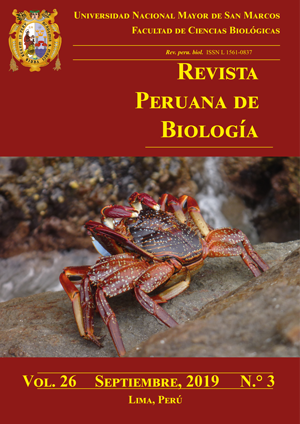Design and evaluation of the expression of a potential DNA vaccine against Tilapia lake virus (TiLV)
DOI:
https://doi.org/10.15381/rpb.v26i3.15516Keywords:
aquaculture, tilapia, structural homology, gene expression, neuraminidaseAbstract
Tilapia Lake Virus (TiLV) is a pathogen that causes massive mortalities in both cultured and wild tilapia populations around the world. The development of an effective vaccine against this emerging pathogen is imperative to prevent economic losses. In this work an expression vector was designed and evaluated as a potential DNA vaccine against this virus. Initially, a threading analysis was done to predict the three-dimensional structures and functions of the TiLV proteins. Structural homologies were found between the TiLV proteins corresponding to the genomic segment 1 and the genomic segment 4, with the RNA-dependent RNA polymerase proteins of the influenza B virus (56%) and the neuraminidase protein belonging to the influenza A virus capsid (12%), respectively. The PCR product of the viral neuraminidase gene was inserted into the expression plasmid vector pCMV. Finally, the plasmid construct was injected into juveniles of the Nile tilapia Oreochromis niloticus and its expression was measured by real time RT-PCR at 8h, 16h, 24h, and 72h after the second immunizing injection. It was possible to detect gene expression in the four evaluated times and greater expression at 16 hours post injection. These results are the first step in the development of an effective vaccine for the protection of tilapia stocks around the world.
Downloads
Downloads
Published
Issue
Section
License
Copyright (c) 2019 Mónica Criollo-Joaquin; Emmerik Motte; Max Salvatierra; Jorge Medina; Benoit Diringer; Gustavo Sandoval; Eric Mialhe

This work is licensed under a Creative Commons Attribution-NonCommercial-ShareAlike 4.0 International License.
AUTHORS RETAIN THEIR RIGHTS:
a. Authors retain their trade mark rights and patent, and also on any process or procedure described in the article.
b. Authors retain their right to share, copy, distribute, perform and publicly communicate their article (eg, to place their article in an institutional repository or publish it in a book), with an acknowledgment of its initial publication in the Revista Peruana de Biologia.
c. Authors retain theirs right to make a subsequent publication of their work, to use the article or any part thereof (eg a compilation of his papers, lecture notes, thesis, or a book), always indicating its initial publication in the Revista Peruana de Biologia (the originator of the work, journal, volume, number and date).






